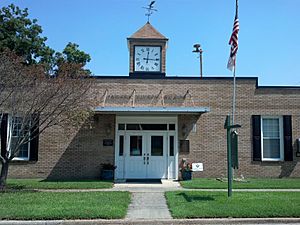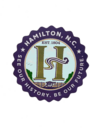Hamilton, North Carolina facts for kids
Quick facts for kids
Hamilton, North Carolina
|
||
|---|---|---|

Hamilton Town Hall
|
||
|
||
| Motto(s):
Hamilton, North Carolina. "See our History. Be our future"
|
||

Location of Hamilton, North Carolina
|
||
| Country | United States | |
| State | North Carolina | |
| County | Martin | |
| Town of Hamilton | 1804 | |
| Government | ||
| • Type | Mayor-Council | |
| Area | ||
| • Total | 0.49 sq mi (1.28 km2) | |
| • Land | 0.49 sq mi (1.28 km2) | |
| • Water | 0.00 sq mi (0.00 km2) | |
| Elevation | 72 ft (22 m) | |
| Population
(2020)
|
||
| • Total | 306 | |
| • Density | 619.43/sq mi (239.11/km2) | |
| Time zone | UTC-5 (Eastern (EST)) | |
| • Summer (DST) | UTC-4 (EDT) | |
| ZIP code |
27840
|
|
| Area code(s) | 252 | |
| FIPS code | 37-29120 | |
| GNIS feature ID | 2406639 | |
Hamilton is a small town located in Martin County, North Carolina, United States. In 2020, about 306 people lived there. The town's motto is "See our History. Be our future," which shows how proud they are of their past.
Contents
Geography and Location
Hamilton is a small town covering about 1.28 square kilometers (or 0.49 square miles) of land. It is located right on the Roanoke River, which is an important waterway in North Carolina.
Population and People
| Historical population | |||
|---|---|---|---|
| Census | Pop. | %± | |
| 1860 | 242 | — | |
| 1870 | 200 | −17.4% | |
| 1880 | 369 | 84.5% | |
| 1890 | 781 | 111.7% | |
| 1900 | 493 | −36.9% | |
| 1910 | 452 | −8.3% | |
| 1920 | 474 | 4.9% | |
| 1930 | 508 | 7.2% | |
| 1940 | 524 | 3.1% | |
| 1950 | 514 | −1.9% | |
| 1960 | 565 | 9.9% | |
| 1970 | 579 | 2.5% | |
| 1980 | 638 | 10.2% | |
| 1990 | 544 | −14.7% | |
| 2000 | 516 | −5.1% | |
| 2010 | 408 | −20.9% | |
| 2020 | 306 | −25.0% | |
| . Decennial Census | |||
The population of Hamilton has changed over the years. In 2020, the town had 306 residents. The community is made up of people from different backgrounds, including White, Black or African American, Native American, and Hispanic or Latino residents.
Hamilton's Rich History
Hamilton was founded in 1804. It was built on the highest point along the Roanoke River, which made it a good spot for a town.
Fort Branch and the Civil War
One of the most important historical events for Hamilton happened during the American Civil War. The town was home to Fort Branch, a strong fort that protected a nearby town called Weldon. Weldon had a very important railroad line that supplied General Robert E. Lee's army.
Union soldiers tried to travel up the Roanoke River from Plymouth to capture Weldon and cut off supplies. However, Fort Branch successfully defended the area. The fort held out until the day after General Lee surrendered at Appomattox Court House.
After the war ended, the Confederate troops left Fort Branch. They threw the fort's cannons into the Roanoke River. Many years later, in July 1972, these cannons were discovered and pulled from the river. There was a legal discussion about who owned these historical items. Eventually, the courts decided that the cannons belong to the state of North Carolina. Today, these cannons are loaned back to Fort Branch, where visitors can see them.
Historic Places and Buildings
The Historic Hamilton Commission was started in 1976. This group helps take care of many historic sites in the county, including St. Martin's Episcopal Church.
St. Martin's Episcopal Church
St. Martin's Episcopal Church was established in 1868 as a missionary station. It was mainly founded by members of the Boyle family. The church officially joined the Episcopal convention in 1873. Building the church started in 1879. Most of the materials used for construction came from local suppliers. However, the church's bell and beautiful stained glass windows were brought all the way from Wales.
The church was officially dedicated on May 17, 1882. While the church is not active today, it is still owned by the Episcopal Diocese of East Carolina. This means it remains a consecrated (holy) church.
The Rosenwald School
Another important historical site in Hamilton is the Rosenwald School. This school was built for Black students during a time when schools were segregated. During segregation, white schools often received much more funding than Black schools.
Julius Rosenwald, who was the president of Sears, Roebuck and Co., created the Rosenwald Fund. This fund aimed to provide support and funding for underprivileged Black schools across the country.
The Roanoke River Partners organization plans to restore the Rosenwald School and use it as their main office. Hamilton is located in the middle of the Roanoke River, which makes it a good central spot for the organization. However, the building is still in need of repair.
Hamilton was once a busy and beautiful Victorian port town with many historic homes. In recent years, the town has been working to bring back its vibrant past.
Images for kids
See also
 In Spanish: Hamilton (Carolina del Norte) para niños
In Spanish: Hamilton (Carolina del Norte) para niños




